Emotional Support Cat Breeds
Have you ever wondered what it’s like to be surrounded by a purring ball of comfort and companionship?
So, no more pondering!
Exploring Emotional Support Cat Breeds is like unearthing a goldmine of feline companions.
It’s as if you’re beginning on a voyage through a library of living, loving books, each with their distinct narrative to tell.
Come along with us as we explore the world of these healing whiskered beauties!
Top Ten Emotional Support Cat Breeds
Choosing the correct cat breed for emotional support can make or break your road toward better mental and emotional health.
Each breed has its own distinct personality features and qualities that might either completely match or fall short of your requirements.
In this blog post, we’ll look at the top ten emotional support cat breeds, their distinguishing characteristics, and why they’re great candidates for comfort and companionship.
1. Ragdoll
Ragdoll cats are known for being gentle and friendly.
They have an extraordinary tendency to bond emotionally with their owners, frequently turning limp when held, hence the term “Ragdoll.”
Their calm demeanor and desire to be near their human companions make them a good choice for emotional support.
Their comforting presence and desire to be held can provide a sense of security and comfort, lowering tension and anxiety.
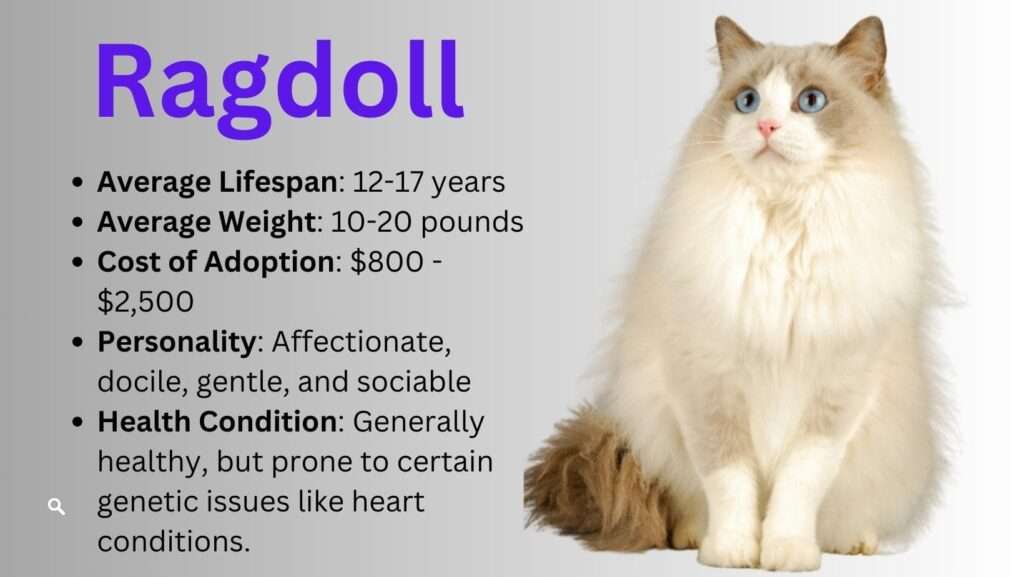
- Average Lifespan: 12-17 years
- Average Weight: 10-20 pounds
- Cost of Adoption: $800 – $2,500
- Personality: Affectionate, docile, gentle, and sociable
- Health Condition: Generally healthy, but prone to certain genetic issues like heart conditions.
- Compatibility: Great for families, seniors, and individuals seeking a calm and loving companion.
- Origin: The Ragdoll breed was developed in the 1960s by Ann Baker in California, USA. It’s believed to have descended from a white Persian cat and a Burmese-like cat, resulting in its unique and gentle temperament.
- Temperament: Ragdolls are known for their gentle and affectionate nature. They love to be held and cuddled, making them a top choice for emotional support.
- Physical Characteristics: They are large cats with striking blue eyes and semi-long fur.
2. Siamese
Siamese cats are well known for their noisy and gregarious nature.
They develop close bonds with their owners and thrive on interaction.
Their conversational personality can provide friendship as well as emotional assistance.
They are emotionally sensitive to their owners and frequently offer attention and warmth when needed, making them ideal for anyone looking for a talkative and devoted friend.
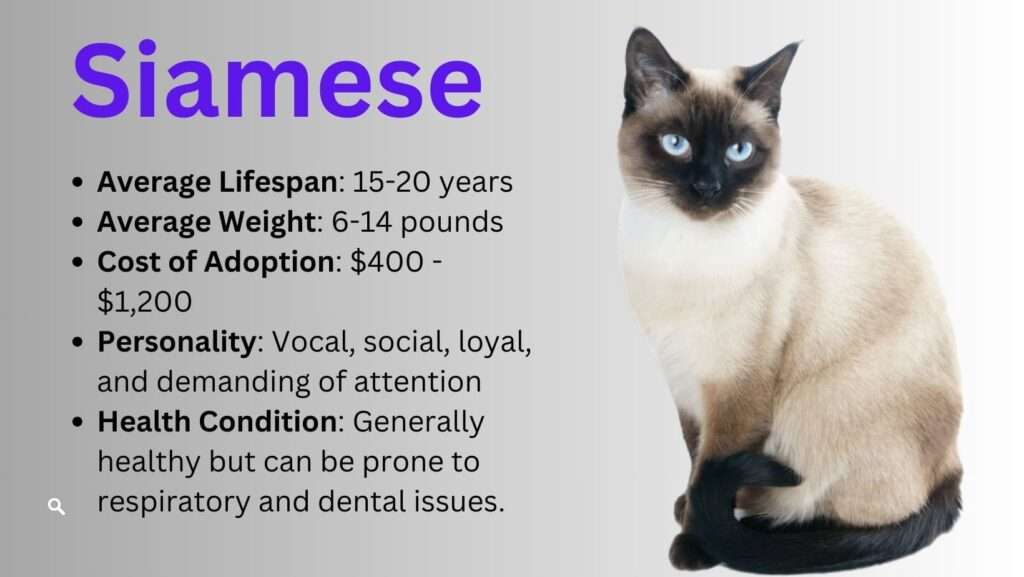
- Average Lifespan: 15-20 years
- Average Weight: 6-14 pounds
- Cost of Adoption: $400 – $1,200
- Personality: Vocal, social, loyal, and demanding of attention
- Health Condition: Generally healthy but can be prone to respiratory and dental issues.
- Compatibility: Ideal for individuals or families seeking a talkative and affectionate companion.
- Origin: Siamese cats have a rich history and are believed to originate from Thailand (formerly Siam). They have been cherished for centuries, and their distinctive appearance and vocal nature have made them famous worldwide.
- Temperament: Siamese cats are vocal, social, and incredibly loyal. They form strong bonds with their owners and are known for their chatty personalities.
- Physical Characteristics: Their sleek, slender bodies and striking blue almond-shaped eyes are hard to miss.
3. Maine Coon
Maine Coon cats are gentle giants with an outgoing personality.
Because of their huge size and friendly attitude, they are great for people looking for a big-hearted emotional support cat.
Maine Coons are recognized for their devotion and playfulness, and their engaging personality and unwavering presence provide comfort.
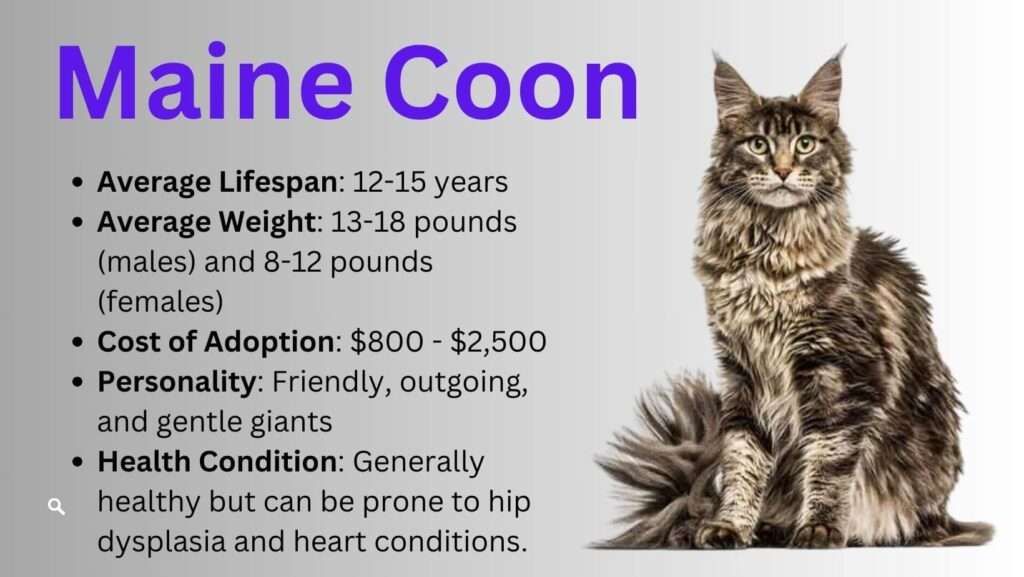
- Average Lifespan: 12-15 years
- Average Weight: 13-18 pounds (males) and 8-12 pounds (females)
- Cost of Adoption: $800 – $2,500
- Personality: Friendly, outgoing, and gentle giants
- Health Condition: Generally healthy but can be prone to hip dysplasia and heart conditions.
- Compatibility: Excellent for families and those seeking a big, sociable cat.
- Origin: The Maine Coon is often considered a native American breed. It originated in the United States, particularly in the state of Maine. Its exact ancestry is debated, but it is believed to have developed from long-haired cats brought by seafarers.
- Temperament: Maine Coons are friendly giants, known for their sociable and outgoing nature. They are great for those who seek a cat with a big heart.
- Physical Characteristics: These cats are among the largest domestic breeds, with bushy tails and tufted ears.
4. Scottish Fold
Scottish Fold cats are recognized for being gentle and adaptable.
Their characteristic folded ears distinguish them, giving them a distinct and appealing appearance.
Their allure stems from their versatility and readiness to interact with their owners. Their fun and affectionate personalities make them ideal partners for emotional support.

- Average Lifespan: 15-20 years
- Average Weight: 6-13 pounds
- Cost of Adoption: $200 – $3,000
- Personality: Sweet-natured, adaptable, and playful
- Health Condition: Generally healthy, but may have joint issues due to the folded ears.
- Compatibility: Suited for families and individuals looking for an affectionate and unique cat.
- Origin: The Scottish Fold breed’s unique folded ear mutation first appeared in Scotland in the early 1960s. It has since become a popular breed known for its distinctive appearance.
- Temperament: Scottish Folds are sweet-natured and adaptable, making them ideal emotional support companions. Their distinctive folded ears add to their charm.
- Physical Characteristics: The folded ears are their most unique feature, but they also have a compact, sturdy build.
5. Sphynx
Sphynx cats, despite their hairless appearance, are extremely friendly and need physical contact.
Individuals needing emotional support may find their warmth and persistent yearning for touch calming.
Sphynx cats are noted for their playfulness and readiness to interact, providing friendship through their physical closeness as well as their vibrant attitude.
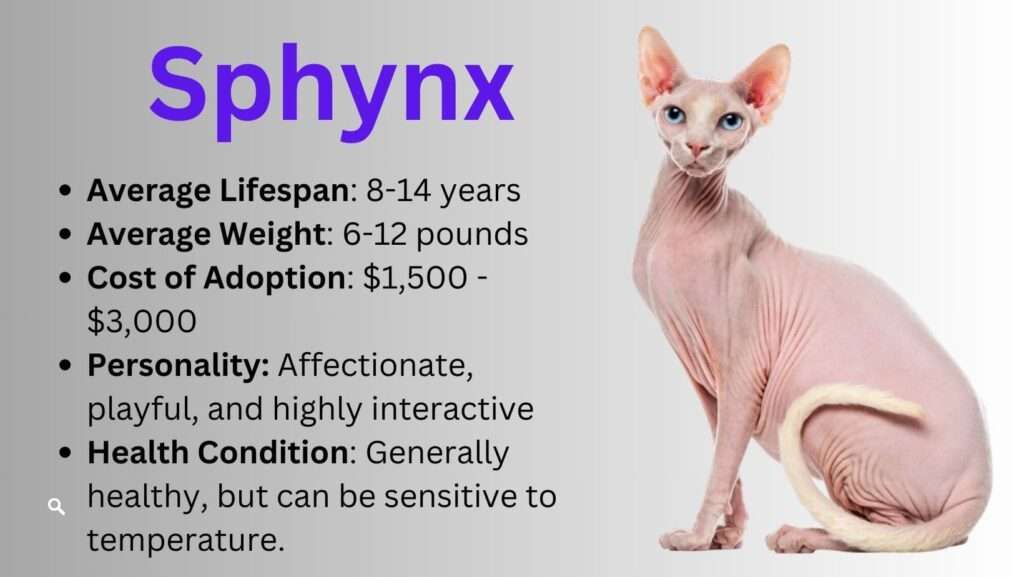
- Average Lifespan: 8-14 years
- Average Weight: 6-12 pounds
- Cost of Adoption: $1,500 – $3,000
- Personality: Affectionate, playful, and highly interactive
- Health Condition: Generally healthy, but can be sensitive to temperature.
- Compatibility: Great for those who desire constant physical contact and enjoy an active cat.
- Origin: Contrary to its hairless appearance, the Sphynx breed actually originated in Canada in the 1960s. It resulted from selective breeding efforts involving hairless cats with domestic shorthair cats.
- Temperament: Despite their hairless appearance, Sphynx cats are known for being incredibly affectionate, making them perfect for those who need constant physical contact.
- Physical Characteristics: Hairless with wrinkled skin, they have large ears and big, expressive eyes.
6. Persian
Persian cats are recognized for their sweet and quiet demeanor.
Their laid-back and easygoing demeanor is ideal for those who value a serene and quiet environment.
They offer emotional support through their calm presence and willingness to offer affection without being overbearing.
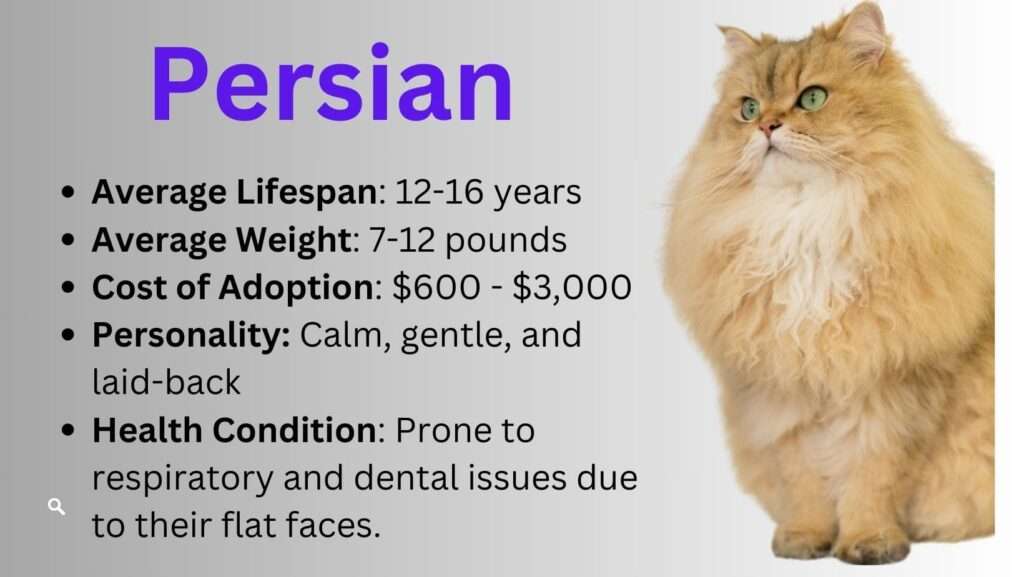
- Average Lifespan: 12-16 years
- Average Weight: 7-12 pounds
- Cost of Adoption: $600 – $3,000
- Personality: Calm, gentle, and laid-back
- Health Condition: Prone to respiratory and dental issues due to their flat faces.
- Compatibility: Perfect for individuals seeking a quiet and serene companion.
- Origin: The Persian cat’s origins can be traced to Persia (modern-day Iran). They were introduced to Europe in the 1600s and have since become one of the most beloved and iconic cat breeds.
- Temperament: Persians are calm and gentle cats that enjoy a quiet and relaxed environment. They offer comfort through their serene presence.
- Physical Characteristics: Known for their luxurious long coats, flat faces, and round, expressive eyes.
7. Burmese
Burmese cats are friendly and outgoing.
They enjoy being near their owners, making them ideal for folks who require companionship.
Their lively and caring demeanor guarantees that you are never truly alone, and their mischievous antics can brighten your day.
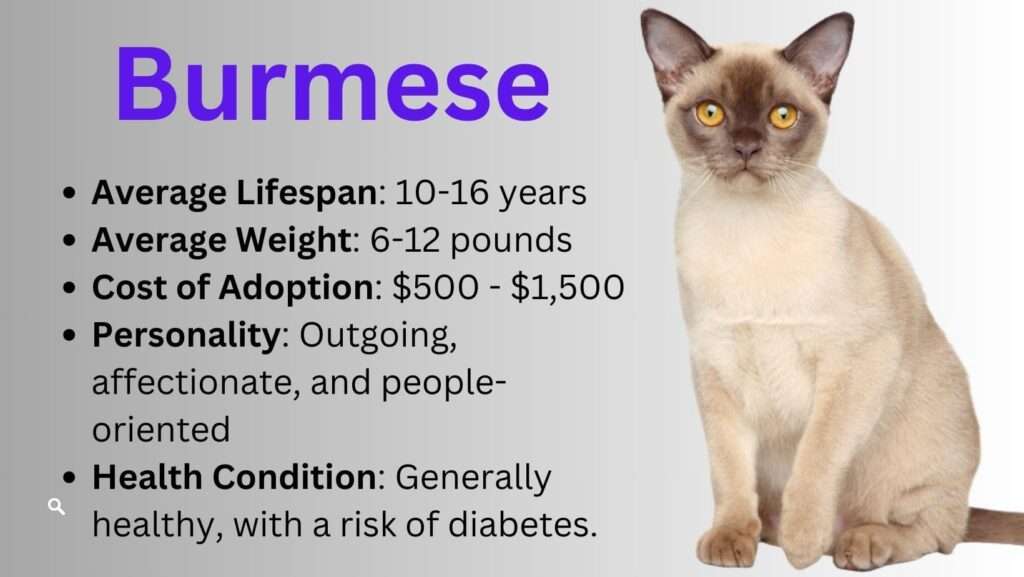
- Average Lifespan: 10-16 years
- Average Weight: 6-12 pounds
- Cost of Adoption: $500 – $1,500
- Personality: Outgoing, affectionate, and people-oriented
- Health Condition: Generally healthy, with a risk of diabetes.
- Compatibility: Ideal for families and individuals seeking an engaging and interactive cat.
- Origin: The Burmese breed has its roots in Burma (now Myanmar). They were introduced to the United States in the early 20th century and quickly gained popularity for their friendly and affectionate nature.
- Temperament: Burmese cats are outgoing and people-oriented. They thrive on interaction and provide emotional support through their engaging personalities.
- Physical Characteristics: Sleek, muscular bodies with short, shiny coats.
8. British Shorthair
The British Shorthair is recognized for its laid-back personality.
They are quiet and undemanding, and their serene presence provides emotional support.
Their low-maintenance lifestyle and easygoing attitude make them excellent for people who seek a companion that is less busy yet still comfortable.
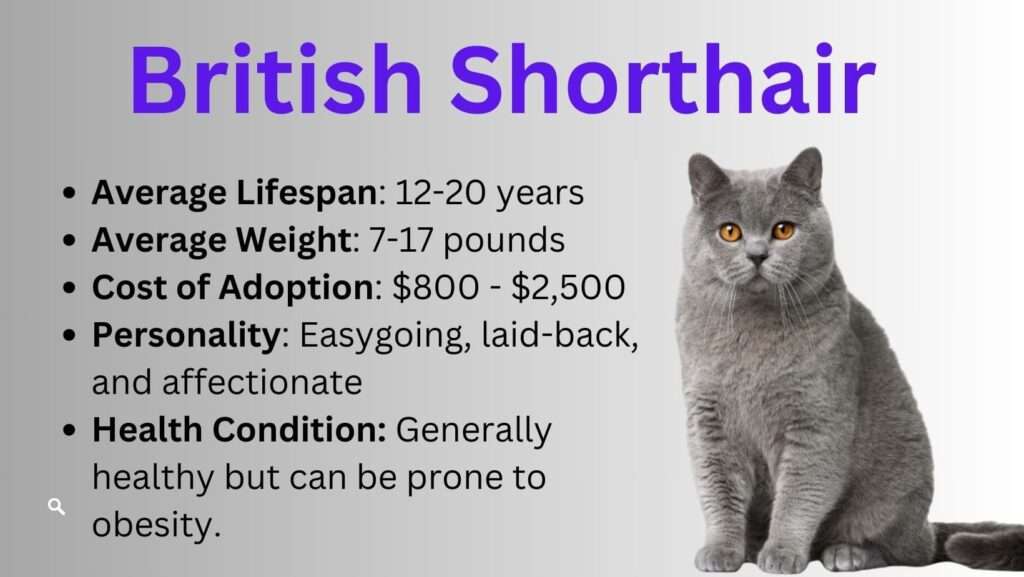
- Average Lifespan: 12-20 years
- Average Weight: 7-17 pounds
- Cost of Adoption: $800 – $2,500
- Personality: Easygoing, laid-back, and affectionate
- Health Condition: Generally healthy but can be prone to obesity.
- Compatibility: Great for families and those desiring a low-maintenance companion.
- Origin: The British Shorthair breed hails from the United Kingdom, where it has a long history dating back to Roman times. It was developed over centuries and is known for its robust and easygoing personality.
- Temperament: British Shorthairs are known for their easygoing and laid-back nature, which can be incredibly soothing for their owners.
- Physical Characteristics: Stocky build, round faces, and dense, plush coats.
9. Bengal
Bengal cats are extremely bright and active animals.
Through their lively and active interactions, they provide emotional support.
Their eye-catching look, complete with leopard-like spots, adds to their attractiveness.
Bengal cats can keep you entertained and involved, making them an excellent choice for anyone looking for an active and vivacious companion.
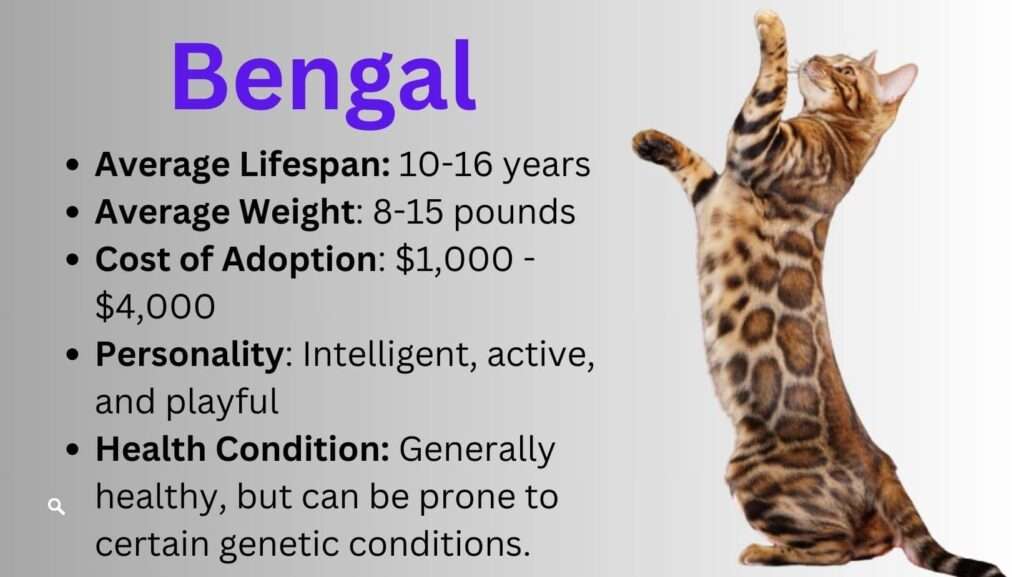
- Average Lifespan: 10-16 years
- Average Weight: 8-15 pounds
- Cost of Adoption: $1,000 – $4,000
- Personality: Intelligent, active, and playful
- Health Condition: Generally healthy, but can be prone to certain genetic conditions.
- Compatibility: Suited for active individuals or families looking for a lively and engaging cat.
- Origin: The Bengal cat is a relatively new breed, created in the United States in the 1960s. It was developed by crossing an Asian leopard cat with a domestic shorthair, resulting in the distinctive wild appearance.
- Temperament: Bengal cats are highly intelligent and active. They can provide emotional support through their playful and energetic interactions.
- Physical Characteristics: Strikingly beautiful, with leopard-like spots and a muscular build.
10. Birman
Birmans are friendly and gentle cats who enjoy being close to their owners.
Through their appealing presence, they provide warmth and connection.
Birmans, with their beautiful blue eyes and silky coats, are ideal for people and families looking for a caring and attentive emotional support cat.
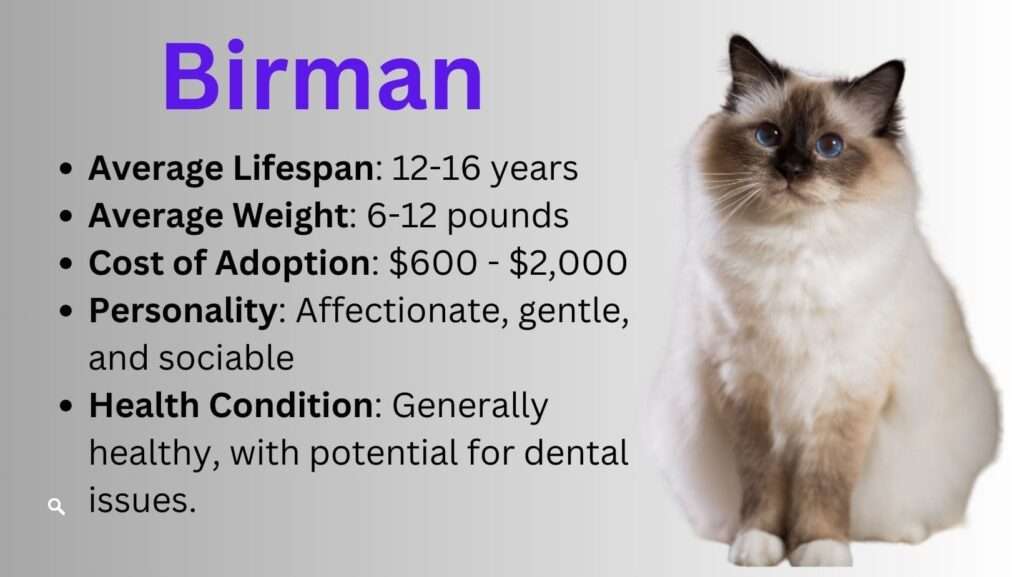
- Average Lifespan: 12-16 years
- Average Weight: 6-12 pounds
- Cost of Adoption: $600 – $2,000
- Personality: Affectionate, gentle, and sociable
- Health Condition: Generally healthy, with potential for dental issues.
- Compatibility: Excellent for families and individuals seeking a warm and loving companion.
- Origin: Birmans, also known as the Sacred Cats of Burma, have their origins in Burma (Myanmar). They are believed to have been brought to Europe in the early 20th century and have since become beloved pets worldwide.
- Temperament: Birmans are affectionate, gentle, and love to be close to their owners. They offer a sense of warmth and connection.
- Physical Characteristics: They have striking blue almond-shaped eyes and semi-long silky fur.
Summary
Choosing the right emotional support cat breed is a personal decision, as it should match your personality, lifestyle, and emotional needs.
These top ten emotional support cat breeds each bring their own unique qualities to the table, and with the right choice, you can look forward to a lifetime of comfort, companionship, and emotional well-being.
Whether you prefer a talkative Siamese, a huggable Ragdoll, or a playful Bengal, there’s a perfect emotional support cat breed waiting to enrich your life and provide you with the support you need.
The Therapeutic Power of Cats
The relationship that exists between humans and their emotional support cats is supported by science and millennia of shared history.
So, let us look into why these furballs have such a therapeutic impact on our lives and the 10 great benefits of having an emotional support cat by your side.
1)- Stress Reduction
Emotional support cats are excellent stress relievers.
Their soft purring and friendly presence offer a calming impact that might aid in stress reduction.
2)- Anxiety Relief
Cats are terrific listeners, and their nonjudgmental attitude makes them excellent companions for people who suffer from anxiety.
Simply caressing your cat can alleviate tension and provide a sense of calm.
3)- Depression Support
When the weight of depression becomes too much to bear, emotional support cats can offer much-needed comfort and inspiration.
Their amusing actions and warm gestures can make you feel better.
4)- Companionship
Loneliness can increase emotional difficulties.
Emotional support cats provide constant companionship, ensuring that you are never truly alone.
5)- Mood Elevation
Cats have an extraordinary capacity to lift your spirits with their playful activities and endearing peculiarities.
Their very presence can cause people to smile and chuckle.
6)- A Sense of Purpose
Caring for a cat instills a sense of duty and purpose in you.
This might be especially good for those who are feeling disoriented or adrift.
7)- Routine and Structure
Cats thrive on routine, and they can assist you in developing a daily regimen, which can be quite grounding for those suffering from emotional issues.
8)- Physical Health Advantages
Caring for a cat frequently involves physical activities such as playing and grooming, which can promote greater physical health and fitness.
9)- Social Interaction
Ownership of a cat might provide opportunities for social contact.
Whether it’s associating with other cat owners or simply talking about your feline pal, these relationships can help reduce feelings of isolation.
10)- Love without conditions
Emotional support Cats provide unconditional love and devotion.
Their love and commitment serve as a reminder that you are treasured and valued.
Summary
Emotional assistance Cats can change people’s lives with their particular blend of warmth, empathy, and comfort.
In this portion, we have discussed the role of different cat breeds in offering emotional support and assisting you in determining which breed may be the ideal match for your individual needs.
Choosing the Emotional Support Cat
Emotional support cats have a remarkable ability to bring comfort, consolation, and companionship to those struggling with a variety of emotional issues, ranging from anxiety to depression.
However, various things should be considered when selecting the best emotional support cat breed.
These elements can have a considerable impact on the efficacy of the cat’s assistance and the harmony of the relationship.
Here, we’ll look at the top ten criteria to consider when choosing an emotional support cat breed.
1)- Allergies and Hypoallergenic Breeds
Allergies can be a major worry for many people, and not all cat breeds are equally allergenic.
If you or someone in your household suffers from allergies, it is critical to select a hypoallergenic cat breed.
Hypoallergenic cats produce fewer allergenic proteins, which can greatly minimize allergy symptoms.
Hypoallergenic breeds such as the Siberian, Balinese, and Devon Rex produce fewer allergenic proteins in their saliva, urine, and dander.
2)-Age of the Cat
Cats of various ages have distinct energy levels and needs.
The age of your emotional support cat should correspond to your lifestyle.
Kittens are more active and demand more attention, whereas adult cats may be more peaceful and prefer a calm atmosphere.
Kittens are energetic and may not be suitable for people looking for a more peaceful companion.
Senior cats are a wonderful alternative for individuals looking for a more laid-back and low-energy cat.
3)- Size of the Cat
Cat breeds range in size from little to huge.
When selecting a cat breed, consider the size of your living space.
Smaller cats may be better suited to apartments, whilst larger breeds may require more area to explore.
Smaller breeds such as the Singapura and Munchkin are suited for smaller living spaces, whereas Maine Coons and Norwegian Forest Cats are larger types that may demand more space.
4)- Temperament
Different cat breeds have distinct personalities and temperaments.
To provide appropriate emotional support, the cat’s disposition must be matched with your emotional needs. Some breeds prefer affection, while others prefer independence.
Ragdolls and Birmans are recognized for their soft and caring personalities, making them excellent alternatives for emotional support, whereas breeds like the British Shorthair are more reserved.
5)- Activity Level
The activity levels of different cat breeds vary.
Consider your level of activity and lifestyle.
If you enjoy being active, a playful and energetic cat breed may be a suitable match.
If you want a more calm environment, a less energetic breed may be a better choice.
Bengal cats are very energetic and demand a lot of play and excitement, whereas Persian cats are more laid-back and prefer a tranquil environment.
6)- Grooming Needs
The truth is that different cat breeds have distinct grooming needs.
If you want an emotional support cat, evaluate your skill and willingness to meet their grooming requirements.
Long-haired breeds, for example, necessitate more grooming.
Persian cats have long, lustrous coats that must be groomed regularly, whereas Scottish Folds have shorter, low-maintenance fur.
7)- Health Considerations
Certain cat breeds are predisposed to certain health conditions.
Be aware of breed-specific health issues.
It is critical to ensure the well-being of your emotional support cat.
Maine Coons are prone to cardiac problems, whereas Siamese cats may have respiratory problems.
Being aware of these breed-specific dangers might assist you in making sound selections.
8)- Lifespan
The lifespans of different cat breeds vary.
Emotional Support Cats and their owners frequently create strong ties. To ensure a long-lasting partnership, consider the cat’s longevity.
Ragdolls and Siamese cats have longer lifespans, often reaching 15-20 years, although larger breeds such as Maine Coons have a lifespan of 12-15 years.
9)- Noise Level
Certain cat breeds are more noisy than others.
Consider a quieter breed if you appreciate peace. Noisy cats can be upsetting at times, especially for people who suffer from anxiety or sensory difficulties.
Siamese cats are noted for being loud, whilst British Shorthairs are quieter and more reserved.
10)- Compatibility with Other Pets
Compatibility is critical if you have other pets.
Make sure the cat breed you choose is suitable for your other pets since a peaceful atmosphere is crucial for emotional support.
Some cat breeds are more social and adapt well to other pets, but others prefer to be the center of attention.
Summary
Finally, selecting the best emotional support cat breed necessitates a careful evaluation of these ten variables.
While each breed has distinct characteristics, selecting one that matches your requirements, lifestyle, and personality can result in a deeply satisfying and supportive friendship.
By considering these aspects, you will be able to make an informed decision that will improve your emotional well-being and the quality of your life with your feline companion.
Legal Rights and Responsibilities
Emotional support animals (ESAs) have received widespread attention in recent years for their role in offering comfort and companionship to people suffering from emotional or mental health issues.
While dogs are frequently the first option for emotional support animals, cats can also perform wonderfully in this capacity.
This section will go over the legal rights and duties that come with owning an emotional support cat.
Legal Rights of the ESA Cat Owner
A)- Housing Accommodations
Individuals with emotional support cats are protected from housing discrimination under the Fair Housing Act (FHA).
This federal law allows people to maintain emotional support for cats in places where pets are normally not permitted.
Landlords must provide reasonable adjustments for people with ESAs, such as exempting them from no-pet policies and additional fees.
B)- Air Travel
The Air Carrier Access Act (ACAA) allows people with emotional support cats to fly free of charge in the cabin of an airplane if they have an ESA letter for travel from a registered mental health practitioner.
Airlines may have special restrictions in place, so it is critical to check with them before traveling.
Responsibilities of Owners with ESA Cats
A)- Obtaining an ESA Letter
Individuals must receive an ESA letter from a registered mental health practitioner to enjoy legal safeguards. This letter should be revised annually and should emphasize the importance of the emotional support cat for the owner’s mental health.
B)- Respect for Others
While ESAs do not need to receive specific training, the owner must ensure that their cat is well-behaved and does not disrupt public or shared spaces.
Proper socialization and training are essential for keeping a well-behaved ESA.
C)- Veterinary Care
It is critical to maintain the health of your emotional support cat.
Regular veterinary examinations, vaccinations, and preventive treatment are required to protect your cat’s health.
D)- Cleanliness and Hygiene
Take care of your cat’s hygiene and cleanliness.
To create a pleasant living environment, proper litter box upkeep and grooming are required.
E)- Considerations for Housing and Travel
When renting, disclose your ESA’s presence to your landlord or property management and fulfill their regulations.
When traveling with an emotional support cat, check the airline’s specific restrictions.
Summary
Having an emotional support cat can provide vital companionship as well as emotional support to people who require it.
Understanding the legal rights and obligations that come with owning an emotional support cat is essential for maintaining a harmonious home environment and navigating public spaces while respecting the rights of others.
Remember to contact a mental health expert and prioritize your cat’s well-being to reap the benefits of this special friendship.
Bottom Line
Choosing the best emotional support cat breed is a highly personal decision that should take into account your own needs, lifestyle, and preferences.
Understanding the distinct characteristics, temperaments, and health issues of various cat breeds will help you embark on a wonderful journey of emotional support and companionship.
Your chosen feline buddy can become a vital source of peace and comfort in your life, whether it’s the delicate devotion of a Ragdoll, the participatory attitude of a Siamese, or the serene presence of a British Shorthair.
| Breed | Features | Reasons to Adopt | Temperament | Physical Characteristics | Average Lifespan | Personality | Health |
|---|---|---|---|---|---|---|---|
| Ragdoll | Gentle, affectionate | Calming presence | Docile, Sociable | Large, semi-long fur, striking blue eyes | 12-17 years | Affectionate, Relaxed | Generally healthy, prone to heart conditions |
| Siamese | Vocal, loyal | Active companionship | Social, Chatty | Sleek, slender body, striking blue eyes | 15-20 years | Loyal, Interactive | Generally healthy, prone to respiratory issues |
| Maine Coon | Friendly, outgoing | Big-hearted companions | Sociable, Playful | Large, bushy tail, tufted ears | 12-15 years | Sociable, Outgoing | Generally healthy, prone to hip dysplasia |
| Scottish Fold | Sweet-natured | Unique charm | Adaptable, Playful | Folded ears, compact build | 15-20 years | Adaptable, Playful | Generally healthy, may have joint issues |
| Sphynx | Affectionate, active | Constant physical contact | Playful, Energetic | Hairless, wrinkled skin | 8-14 years | Playful, Interactive | Generally healthy, sensitive to temperature |
| Persian | Calm, gentle | Serene presence | Calm, Relaxed | Luxurious long coat, round face | 12-16 years | Calm, Gentle | Prone to respiratory and dental issues |
| Burmese | Outgoing, affectionate | Engaging interaction | People-oriented | Sleek, muscular body, short, shiny coat | 10-16 years | Affectionate, Playful | Generally healthy, risk of diabetes |
| British Shorthair | Easygoing | Low-maintenance choice | Laid-back | Stocky build, dense, plush coat | 12-20 years | Easygoing, Laid-back | Generally healthy, prone to obesity |
| Bengal | Intelligent, active | Playful companionship | Playful, Energetic | Strikingly beautiful, leopard-like spots | 10-16 years | Intelligent, Active | Generally healthy, prone to certain genetic conditions |
| Birman | Affectionate, gentle | Warm and loving presence | Gentle, Sociable | Striking blue eyes, semi-long silky fur | 12-16 years | Affectionate, Gentle | Generally healthy, potential for dental issues |
FAQs
What are the best cat breeds for emotional support?
Ragdoll, Siamese, Maine Coon, Scottish Fold, Sphynx, Persian, Burmese, British Shorthair, Bengal, and Birman are some of the best cat breeds for emotional support.
What are the benefits of having an emotional support cat?
Emotional support cats can provide comfort, companionship, and stress relief to individuals with mental health issues.
How do I know if a cat is a good emotional support animal?
A good emotional support cat should be sociable, calm, and not easily startled. They should also be able to adapt to new environments and not be bothered by loud noises or other animals.
Do I need an ESA letter for my emotional support cat?
Yes, you will need an ESA letter from a licensed mental health professional to qualify for legal protection under the Air Carrier Access Act and the Fair Housing Act.
How do I get an emotional support cat?
If you already own a cat that provides emotional support, you can get an ESA letter to document that your cat is more than just a pet. Otherwise, consider adopting a cat from a shelter or rescue organization.
What should I consider before getting an emotional support cat?
You should consider your living situation, work schedule, and family commitments before getting an emotional support cat. You should also ensure that you have the time and financial resources to care for a cat.
Can any cat breed be an emotional support animal?
While any cat breed can provide emotional support, certain breeds are more disposed to show lots of love, affection, and cuddly nature.
How do I know if a cat is a good fit for my personality and lifestyle?
Consider your living situation, work schedule, and family commitments when deciding which cat is best for your needs while always keeping the animal’s best interest in mind.
What are some tips for raising a kitten as an emotional support cat?
Provide a safe and comfortable environment, socialize your kitten with humans and other animals, and provide plenty of playtime and mental stimulation.
What are some questions to ask before getting an emotional support cat?
Do you have the time and financial resources to care for a cat?
Is your living situation a good fit for a cat?
Will you need an ESA letter to live with your cat?
How do the people you live with feel about having a cat?
Who will take care of your cat if you are unable to?
